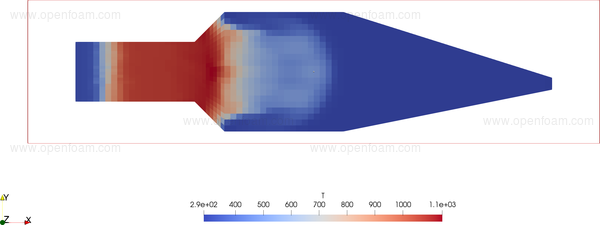OpenFOAM® v1806: New boundary conditions
New outlet Mach number condition
This pressure boundary condition maintains a (subsonic) Mach number at an outlet patch by dynamically adjusting the static outlet pressure. It makes it possible, for example, to simulate the flow in a pre-turbine engine exhaust manifold without resolving details of the flow inside the turbine.

The formulation is derived from a simple model of the gas flow through a nozzle with fixed geometry. The nozzle flow is assumed to be quasi-steady, 1D, isentropic and compressible.
The accompanying boundary conditions for velocity should be pressureInletOutletVelocity
- Source code
- $FOAM_SRC/TurbulenceModels/compressible/turbulentFluidThermoModels/derivedFvPatchFields/outletMachNumberPressure
- Examples
- $FOAM_TUTORIALS/combustion/reactingFoam/RAS/chokedNozzle
New swirl fan velocity condition
This condition can be used in combination with a cyclic pressure jump condition to simulate a fan. The existing fan pressure jump condition implements the fan-normal momentum gain. This new velocity jump condition adds a swirl component.
The velocity jump can be specified in two ways:
- constant velocity
- constant swirl
In the first mode the velocity is calculated as follows:

Where  represents the current pressure drop across the cyclic,
represents the current pressure drop across the cyclic,  is the
effective radius,
is the
effective radius,  is the fan efficiency coefficient and
is the fan efficiency coefficient and  the speed of the
fan (in revolutions-per-minute).
the speed of the
fan (in revolutions-per-minute).
In the second mode the inner ( ) and outer (
) and outer ( ) radii are provided instead
of
) radii are provided instead
of  , where for
, where for  and
and  the velocity is given as:
the velocity is given as:

where  is the distance from a patch face to the fan axis. Outside
is the distance from a patch face to the fan axis. Outside  and
and  ,
,
 . The input for this mode is:
. The input for this mode is:
rInner 0.005;
rOuter 0.01;
origin (0.0453 0.06 0);
If the  is not provided the centroid of the patch is taken.
is not provided the centroid of the patch is taken.
New wave modelling: irregular waves
A new irregular wave model based on the frequency-direction spectrum has been added to the suite of available wave models.
The wave height is set according to the equation:

![[Picture]](/releases/openfoam-v1806/img/v1806-waves-ihc-irregular-00-grad.png)
![[Picture]](/releases/openfoam-v1806/img/v1806-waves-ihc-irregular-20-grad.png)
- Source code
- $FOAM_SRC/waveModels/waveGenerationModels/derived/irregularMultiDirectional
- Examples
- $FOAM_TUTORIALS/multiphase/interFoam/laminar/waveExampleIrregularMultiDirection
- Attribution
- These boundary conditions were supplied by the Environmental Hydraulics Institute IHCantabria
- Integration
- The code has been updated by OpenCFD and added to the $FOAM_SRC/waveModels library available to the interFoam family of solvers

